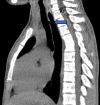Adolescent With VACTERL Association Presents With Recurrent Pneumonia
- PMID: 33062488
- PMCID: PMC7550003
- DOI: 10.7759/cureus.10365
Adolescent With VACTERL Association Presents With Recurrent Pneumonia
Abstract
VACTERL is a condition that includes various anatomic anomalies including vertebral, cardiac, tracheoesophageal fistula (TEF), renal, and limb defects. TEF can be found in up to 80% of patients with the condition. Although TEFs are usually identified early in life, the H-type TEF can be more difficult to detect. We report the case of a 15-year-old male with a previous diagnosis of VACTERL who presented with a history of recurrent pneumonia, chest pain, and asthma and was found to have a previously undetected H-type TEF that was surgically repaired. When evaluating a patient with features of VACTERL, it is important to choose studies that can explore the presence of all associated features. Clinical history and type of imaging utilized can be essential in making a timely diagnosis, especially for H-type TEF.
Keywords: h type tef; tef; tracheoesophageal fistula; vacterl.
Copyright © 2020, Stack et al.
Conflict of interest statement
The authors have declared that no competing interests exist.
Figures



References
-
- An approach to the identification of anomalies and etiologies in neonates with identified or suspected VACTERL (vertebral defects, anal atresia, tracheo-esophageal fistula with esophageal atresia, cardiac anomalies, renal anomalies, and limb anomalies) association. Solomon BD, Baker LA, Bear KA, et al. J Pediatr. 2014;164:451–457. - PMC - PubMed
-
- VATER non-random association of congenital malformations: study based on data from four malformation registers. Kallen K, Mastroiacovo P, Castilla EE, Robert E, Kallen B. Am J Med Genet. 2001;101:26–32. - PubMed
-
- Esophageal atresia: lessons I have learned in a 40-year experience. Spitz L. J Pediatr Surg. 2006;41:1635–1640. - PubMed
-
- H-type congenital tracheoesophageal fistula: University of Iowa experience 1985 to 2005. Brookes JT, Smith MC, Smith RJ, Bauman NM, Manaligod JM, Sandler AD. Ann Otol Rhinol Laryngol. 2007;116:363–368. - PubMed
Publication types
LinkOut - more resources
Full Text Sources
